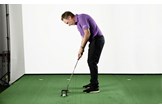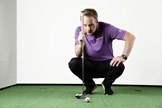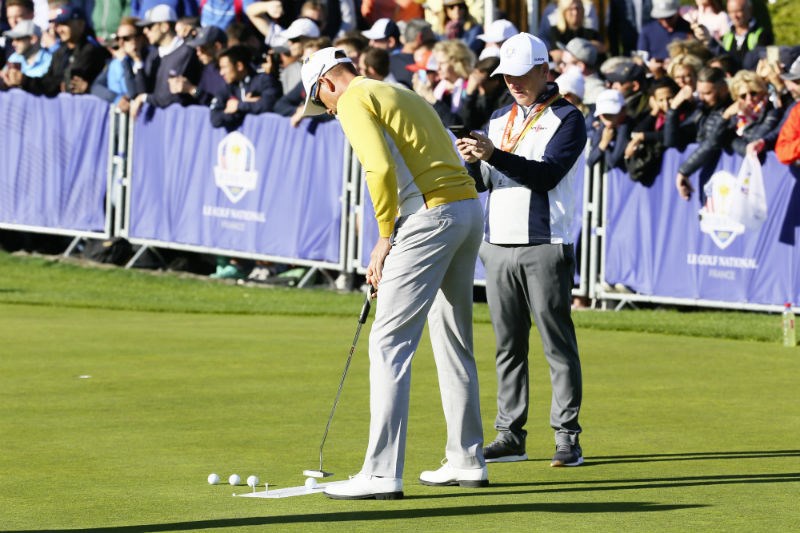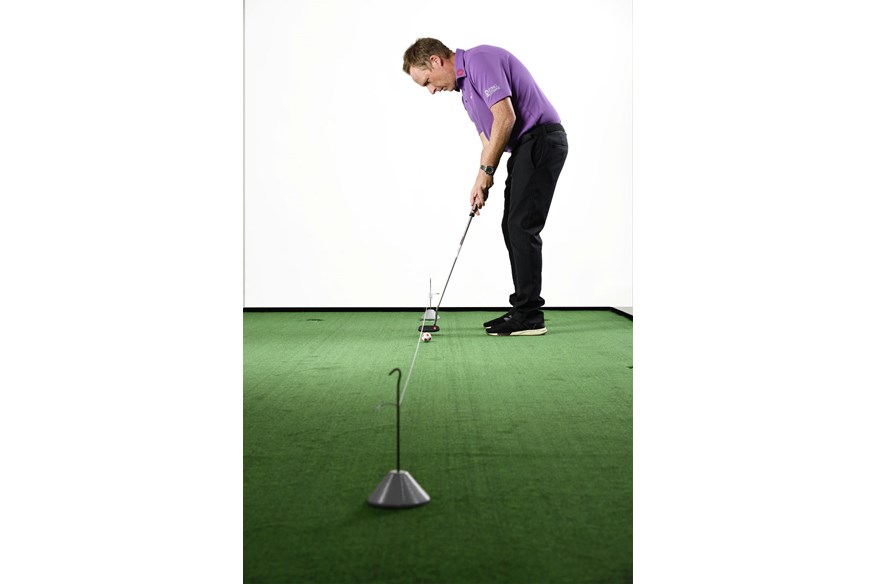Phil Kenyon: ‘Irrespective of your handicap or status, everyone can putt well’
Last updated:
Golf’s biggest stars are queuing up to work with Phil Kenyon, Britain’s foremost putting teacher
Phil Kenyon is probably the greatest coach you do not know. Some of that comes down to choice, hence you rarely see him on TV screens, but it doesn’t help that he’s a master in the field of putting, the one part of the game golfers struggle to get excited about. Only the serious players, he admits, come for a golf lesson. The rest of us suffer in silence.
It’s an attitude Kenyon has battled to change ever since he started working as an apprentice for Harold Swash, the legendary “Putting Doctor”. “I was his cameraman and bag-man,” he says. Kenyon was a tour pro in those days, in need of some extra income. But as the money dried up on the course, he swapped the mini tours for university, where he completed a master’s degree in sports psychology.
In his late 20s, Kenyon returned to coaching full-time as Swash’s assistant. As he worked his way up, he worked his way back to the tour, where he was introduced to Henrik Stenson by Pete Cowen in 2008. Within a matter of days, he had his first high-profile client. As other players took notice, Kenyon’s reputation grew and he became the go-to putting man for many of the world’s best.
At the Ryder Cup in Paris, he could be found casting his eye over the strokes of Francesco Molinari, Justin Rose, Tommy Fleetwood and Henrik Stenson. Rory used to be part of that list, as did Thomas Bjorn. In fact, you’d be hard pressed to find a player who hasn’t worked with, or wanted to work with, the softly spoken 44-year-old from Southport.
Demand is now so high that he’s had to limit who he works with. Luckily for us, we made the cut and travelled to the Putting Solutions Studio at Formby Hall so we could find out exactly where millions of golfers are going wrong – and what we can learn from the putting stroke and grip of a Major winner… (jump to drills)

Justin Rose’s tendencies were typical of most club golfers.
When I started working with him at the 2016 Open in Troon, he had a push pattern in his stroke and would aim left to compensate. That was difficult for him to manage, so we tried to match up how he controls the rotation of the putter head with his alignment and green reading. Really, I wanted to help him simplify things, because he would spend a lot of time drilling his technique. Since then, we’ve put into place some processes to randomise his sessions and stop him tinkering around as much.
One of the big changes we made was changing the position of Justin’s right arm to help him release the putter head better.
Just prior to the Ryder Cup at Hazeltine, we were exploring different techniques and testing a few different putters. We tested a claw grip and the numbers were unbelievably good. We were sat in his golf studio afterwards and the debate was whether to make the change there and then. I told him at the time that you’ve got to be prepared to putt really poorly, using that, at the Ryder Cup. If you’re not, it’s the wrong time to change.
He chose not to, because it would have been a big change and hard to fully embrace in that environment. I think that was a good thing because he didn’t putt very well at the Ryder Cup, and as a consequence we had a ready-made Plan B waiting to go. Luckily, the change in grip has really helped to manage certain aspects of his stroke and feel. If you look at his strokes gained: putting stats, they are the best they’ve ever been. He had never been inside the top 100 (on the PGA Tour), and yet he finished 17th for the 2018 season.
Putting is one area of the game where you can make a big improvement quickly.
Irrespective of your handicap or status, everyone can putt well. I’m never going to drive it 320 yards, no matter how hard I work in the gym or on the range. I’m limited. Whereas in putting, that’s less of a problem. It’s not like you need a certain amount of physical talent to putt well. I teach guys who play low-level golf, but putt well. I don’t see many 20 or 10 handicappers drive it like DJ, but I see some putt it better than some tour pros.
What works for Rose or Molinari might not work for you.
Technology shows that everyone moves the putter head differently, and as a consequence I don’t believe you can prescribe a remedy or recommend one grip which will suit everyone. It’s more about matching the hand placement with the pattern of your stroke. It’s a bit like a puzzle, because it’s not only the placement and pressure of the hand which has a big impact on the wrist sequence, and the orientation of the clubface, but also your arm position and how your shoulder and elbow sits. It can be tough to manage on your own, which is why it’s important to go for a lesson and have someone go through that problem solving with you.
Most amateur golfers don’t control their speed or swing length very well, and hit putts using the same backswing. Any variance in speed comes from acceleration. One of the biggest myths perpetuated in golf is that you need to accelerate into impact, when actually the best putters in the world tend to decelerate slightly. Think about it: You hit every putt with your backswing; you don’t hit a putt with your follow-through.
There’s no such thing as a “textbook” set up.
We’ve measured over 100 tour pros using 3D technology and not one person stood square to the target. The average tour player aligns seven degrees open, ranging up to 20 degrees open. My point is that their set up is geared towards helping their stroke function. If you cut across the ball and hit pulls, standing open won’t help. Working more towards square will neutralise that. Whereas, if you’re someone who hits pushes and swings in-to-out, standing open could help.
Every golfer would benefit from having their stroke measured.
TrackMan now has a putting measurement, and there’s also Quintic Ball Roll and SAM PuttLab, so there’s a lot of options available to you. At Formby Hall, we use a system – GBD – which measures the body as well as the putter in 3D. I think if you use technology wisely, it’s very good because you can understand better what you do and what needs improvement. Ultimately, though, it’s down to the skill of the coach to decipher that information and say what’s relevant to you.
The type of putter you have is important, but I do think it is overstressed at times.
Most peoples’ strokes are so inconsistent that a slight change in putter head doesn’t have much of an effect. Different head shapes and how they affect the rate of rotation may be more important for the better player, but more so it’s about the length, lie and loft. All three affect your set up, which then influences your technique.
Phil Kenyon: 5 Drills To Help You Become A Better Putter

DRILL NO.1: MY FAVOURITE PUTTING DRILL
The most important thing, I believe, is your ability to hit your start line. I often create a drill relative to each player and the parameter of their stroke, which they can use to calibrate what they are doing on a daily basis. A lot of times it’s as simple as finding a straight putt and creating a gate, about 5cm wide, which they have to putt through.
I try to encourage most tour pros to do this, because it highlights any tendencies and tells you if your read was any good. It’s the best kind of drill. You can use two tee pegs or buy ready-made gates that have different widths for different degrees of error.
Other variations include setting up to a straight putt and using a chalk line or an elevated piece of string, held together by two kebab skewers from your Saturday night out. If the ball starts rolling outside that line, you’ll know you’ve got a problem with your start line.
DRILL NO.2: BUILD A BALANCED STROKE
To stop swinging short and accelerating so aggressively, try and groove your stroke so your swing length stays fairly equal. A simple way to do this is by using two tees or balls, and placing one a foot behind the ball, and the other a foot in front. The key is to keep the distance evenly spaced, and to focus on swinging your putter with an even rhythm. You’ll actually find it difficult to accelerate, and should see far greater consistency in your speed control.
As you progress, try and set up multiple stations for short, medium and long putts. Just make sure the spacing between the balls and/or tees is equal.

DRILL NO.3: PERCEPTION MUST MATCH REALITY
One misconception is that the eyes must be over the ball. But that’s not strictly true. It varies player to player, because what’s important is how you see straight or square. To find out, pace out a 10ft putt and then place a ruler underneath a ball so it points directly at the centre of the hole.
As you take your address, note how your perception and where the ruler points changes as you alter your neck bend or adjust your distance from the ball. The important thing is that the ruler looks like it’s pointing dead centre. Once you find that position, reset again and again until you are confident that you can setup in the same position every time. It may seem tedious, but it’s a great way to make sure your set up is consistent and correct.

DRILL NO.4: GET GROOVY WITH A METRONOME APP
The average golfer gets slow and short in the backswing, which then throws their tempo off and forces them to accelerate into and after impact. You can download metronome apps to improve your tempo, but you need to be careful. The beats are evenly spaced, whereas the putting stroke isn’t evenly spaced. By that I mean the backswing is one unit of time, and the downswing into impact is half a unit of time.
So, where does that beat fit in? It’s easy for someone to mistake the second beat as an indicator for the strike point, rather than the completion of the stroke, and to decelerate as a result. You would be better off purchasing a specialist app which creates a 2:1 ratio, rather than a 1:1.

DRILL NO.5: HOW PROS IMPROVE PUTTING
1. When Tour pros practise their putting, sessions are often split into three parts. The first is based around feedback, and using things like gate drills or mirrors. If a player is working on their set up, they might place a mirror on the ground or use a putting template to give them feedback on their stroke shape and what it needs to feel like.
2. Once they’re feeling comfortable, the next step is on developing skills, and that can involve using certain exercises to test their green reading or ability to control their speed and match it to their start line. A great drill is to read a putt, get a feel for where you want to start the ball and place a gate down and roll the ball through it. If the ball doesn’t go in, it’s either a speed or a read issue.
3. The final part is usually some kind of performance drill, where there’s no feedback or focus on technique. The challenge is to get the ball in the hole. The hurricane drill is a perfect example.
To set it up, place six balls around the hole so the first putt is from three foot, the next is from four foot, the one after that is from five foot and so on.
It should create a spiral around the hole so every putt is a different distance and angled across the slope, and requires you to control your speed relative to the read. Added to that is the pressure of needing to hole every putt. You can only move on once you’ve holed all six putts consecutively. You could be there for a while, but it focuses the mind, makes it more relevant and incorporates lots of skills.













